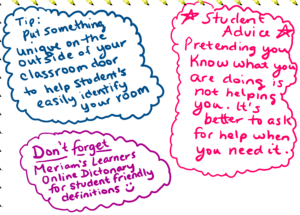Observational Report #3
Mrs. Sara McManus
School of Education, University of Northern British Columbia
EDUC 390: Observational Practicum
Melanie Baerg, M.Ed. – Lecturer
November 14, 2021
On November 2, 2021, I returned for my second observational practicum at School B. I was looking forward to our day at the junior school, as I had recently spent the day as a TTOC in one of the observation classrooms. My Teacher Candidate partner and I hoped to switch “Pods”, as we had such different experiences in the first observation, and I really wanted to meet the teacher who I had subbed for to see her with her students. Unfortunately, the school administrator denied our requests to swap places for the day. Although the Principal understood my reasoning and the value of such an opportunity, she could not articulate a good reason for not making the change; it felt like a “because I said so” situation. Therefore, I spent the day with the two Pod teachers I had previously observed. They explained that if the Principal had switched our observations without their consent, she would have likely received push-back. Fortunately, these two Pod Teachers are union reps, and they will see what they can arrange for our next visit at School B. For ease of reference, I will call the Pod Teachers, Ms. S. for the Science & Math Teacher, and Ms. E. for the English and Socials Teacher.
The second school I went to for this observation report was School C on November 9, 2021; this was also my second visit at this “affluent-sporty” elementary school. I independently observed in a Grade 6-7 classroom for the day with a teacher who is the same age as I am. I will call her Ms. Q. because we graduated from Quesnel Secondary School together. Although we were not close friends during high school, it was very nice to spend the day discussing education with someone who has the same memory of how school was as I do. On my day of observations, the grade 7 students wrote their Foundational Skills Assessments during the morning. Ms. Q. stated that it would be an unusual morning in her class; however, I found it engaging to observe.
I had to engage the classroom teachers in conversations to draw out information from them for both focal points: teaching for equity, diversity and inclusion, and professional boundaries. In my email dated November 3, 2021, I wrote briefly regarding the Universal Design Learning used at School B. I will weave other highlights regarding this focal point throughout the remainder of my report. However, I do not have anything specific to write about on professional boundaries at this time. I do intend to reflect extensively on this issue in my upcoming Cross-Curricular Reflexive Writing assignment for EDUC 393.
The first block at School C was Science 8. Ms. S. placed a note on her door, and we moved to the Science Lab room which was four doors down the hall. Apparently, that was a very confusing instruction for grade 8’s to follow on a Tuesday morning. The second half of the class was a hands-on activity allowing students to try a microscope for the very first time. The students selected five slides to view and were asked to draw and describe what they saw through the microscope. All the students loved it. That wasn’t my favourite part of the class; I loved the first half of the class more. I love to watch authentic teaching and practical techniques that I can apply in the future. I really love it when it feels right—an ah-ha moment that’s putting it all together! Ms. S. began her class with a scanned copy of the previous day’s assignment on the smartboard. Using the pen to write the answers on the screen, she worked her way through each question with the students sharing their answers aloud. She thoughtfully included all the students in reviewing the assignment; this kept the entire class engaged and actively learning and provided for both visual and verbal learners. Students who were missing the day before were to write down the answers and note that they were absent. This structure allowed most students the opportunity to learn individually and then review as a group. For those who had not finished the assignment, this allowed them to continue their learning rather than skip over it as incomplete. Students who had made a mistake were to correct their answers but also needed to record their actual score.
I was so please when I saw Ms. Q. at School C do something similar in her morning work with the Grade 6 students. Each student had a general knowledge quiz that they were working on when they arrived from a lesson the day previous. Ms. Q. had a scan of the quiz ready to go and reviewed each question one at a time with the students, in the same manner to reinforce their learning before moving on to the next topic. In both classes, students marked their work and submitted it to the teacher with a score on the top. (So smart – two for the price of one: review and assessment!)
Ms. S.’s second block was Math with the same Pod students; this was a fantastic hands-on lesson on fractions with Cuisenaire Rods. (She gave the same lesson later in the afternoon with another class of students using fraction circles. It was great to see how either tool could work.) In this block, I learned how to use new technology and a new way to teach fractions without paper! It was an inclusive lesson in which all students could participate easily, but you could see that it was still challenging to everyone on some level. At School C, Ms. Q. also made certain that her math was diversifiable for all her students. She used a scope and sequence program called Math Minute. Every morning, she front-loads her Math in the early morning, allowing the students to work independently to try all the questions. Then before lunch the entire class works through all the questions as mini lessons. Both of these teachers use formative assessment to drive their lessons—neither one moving forward until the class is at the necessary level of understanding to move on.
One thing that has weighed heavily on my mind since my observation of Ms. S.’s fraction lesson is the stark contrast in the teaching philosophies between the junior and high school math departments. I know that my insight is limited, and I do not have the whole picture, as I have only observed one junior classroom two times. However, my experience teaching Math 8-11 in an alternate setting and now in the main high school is giving me a unique perspective to see both sides. From my perspective it is plain to see that the elementary and junior schools have generally accepted the movement towards more formative assessment and the use of hands-on and non-paper-based ways of learning mathematical concepts; whereas the high school is heavily based on summative assessments (up to 80%) with workbook/sheet practice (sometimes with no marking or feedback to the students). I have found it difficult as a teacher moving from the alternate setting, where students were always able to improve their marks through corrections and there were no tests, into the main high school, where tests are everything and “drill and kill” is the status-quo. I can’t imagine how difficult it must be for students coming up through primary, intermediate, and junior school learning math concepts and being assessed so differently than what they experience when they reach grade 10.
Moving away from Science and Math, the next block I observed at School B was an English 8 class with Ms. E. When I came into the room, she had all the overhead lights turned off. There was a single lamp glowing beside her fish tank, and the only other lights in the room were from her computer monitor and the smartboard, which projected a scanned copy of the story she planned to read; this was clearly not her first rodeo. She knew that by reading the story aloud and having the students follow along on the smartboard, she would engage more students in the story. During her reading, she would pause and point out words, phrases, and other key elements that the students might need to remember for their assignment later. Ms. E. thoughtfully engaged her students in brief questions where it was appropriate, like what they thought would happen next. In the same way, Ms. Q. also used this technique in her class during her Health lesson, although she did not have the dramatic dimmed lighting. She also added in the opportunity for students to take turns reading. After each of these lessons, both teachers talked with me about the importance of reading aloud to ensure that all students have access to the content. I do not think that either of the teachers were implying that students didn’t need to be able to read, but they were both aware that the reading levels in their classes were very diverse. In order to include all students in an active class discussion or group work, it was the best way to ensure all students had the same information in the same amount of time. This is a scary idea. It almost feels like defeat in a way. It shines a little light on how students can manage to get to secondary school without being able to read to grade level. On the other hand, how could you operate an inclusive classroom effectively and allow students to feel success without finding strategies like these group readings?
To conclude this observation report, I want to add that my practicum notes are filled with little tips and tricks that I have picked up. Here are a few of my favourites from these observations:

